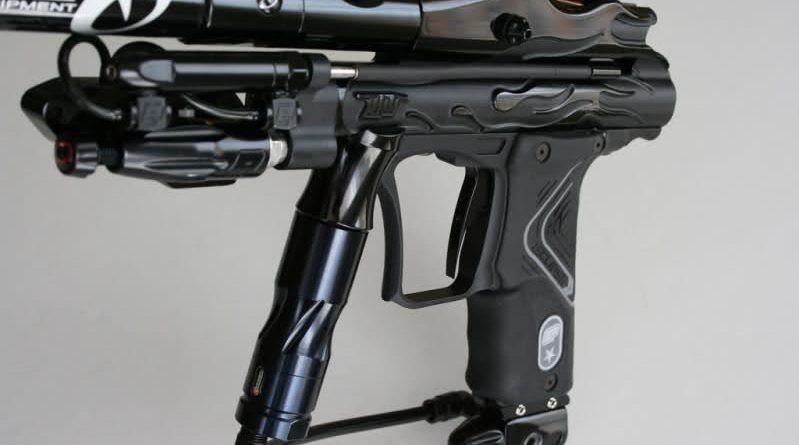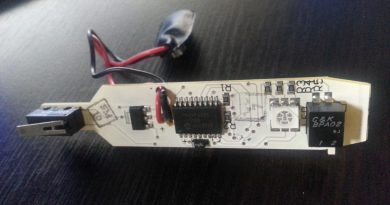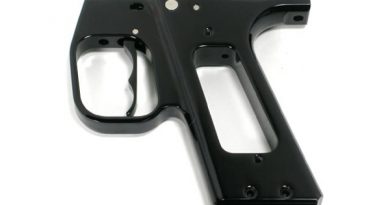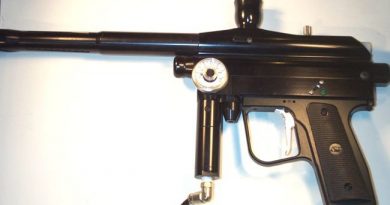Black Magic STO Autococker Review
All we can say is two words: SWEET and NESS. The Black Magic Autococker is absolute “sweetness”.
To the football world, the late Walter Payton came to be known as ‘Sweetness’ and anyone talking football immediately conjures up images of Payton running and diving when one inadvertently says ‘Sweetness’.
Like Payton, the Black Magic ought to be called ‘Sweetness’. Payton broke records and set new standards for running backs all around the NFL. The Black Magic will now set higher standards for the paintball industry.
No other marker, since the WDP Angel first came out, has ever elicited such a response from our staff.
It is here. The Black Magic Autococker is finally here. The paintball industry has been waiting for quite sometime, but the wait is now over. The Paintball Times is the only place you will see this information.
The marker that has proven itself worthy of a Noble Prize has now evolved even further. The Black Magic has undergone some basic testing and the results are in. Look for future updates wherein the Black Magic will be compared to other aftermarket autocockers.
The review is broken up into four separate sections; basic information, a detailed overview, a review of how the marker shoots in actual paintball situations, and how various upgrades affect the marker.
Special thanks:
Special thanks to Bud Orr of WGP for sending us this work of art, to Erich Garber from Action Enterprises for allowing us to test the marker at his facilities, Toledo Indoor Paintball and Toledo Action Games, to Mike Gomez of Michigan Paintball for testing the marker and offering some of his opinions.
Black Magic Autococker Basics
The Black Magic Autococker has a manufacturer’s suggested retail price of $850. Here are some basic pictures and a quick overview of the specifications.
What does it come with?
The Black Magic Autococker comes in a standard 2001 autococker box, except for a “BM” and serial number printed on the side. Click for a picture of all the parts that came with the gun.
In the box:
-expertly milled and anodized autococker body with vertical feed and angled air supply adapter (ASA)
-STO front block pneumatics all chrome plated
-custom high flow bolt with venturi style face
-non-sloted trigger plate
-J&J custom two piece barrel anodized to match
-WGP barrel plug
-extra high flow front block banjo retaining screw
-Shocktech 45 grip frame, chrome plated
-Hogue wrap around rubber grips
-custom WGP regulator
-one hex wrench and other odd parts
-custom drop forward with screws
-beavertail, chrome plated
More pictures:
Take a look at the back block. It is similar to the standard 2000 autococker’s block, but is anodized to match the rest of the body.
Take a closer look at the custom milling and Black Magic logo on the autococker side. Unfortunately, you won’t be able to see the milling below the cocking arm. The body is completely drilled through. This makes the gun very light. We hope to have a better picture later.
Take a look at the bolt from a side angle and then from a top angle.
Take a look at the front pneumatics.
The full gun all parts attached.
Firstly, we are into functionality, not looks. With that in mind, please delve yourself further.
The Body:
The Black Magic has a uniquely milled body. There are no corners, all the edges are rounded off. The body is milled on both sides for a cocking arm. Only the crucial parts are left, there are very wide open holes in the body, but the bolt and internals are not exposed. That is excellent. There is a flame pattern of milling along the side, which adds a special ‘Black Magic’ pizzazz to the marker.
Although we are not particular for anodized and splashed markers, the blue anodizing on this marker looks just right. We were terrified when all the STOs started coming in all sorts of fade anodizing, but we are happy to announce that this blue actually looks very good.
It has a vertical feed and a sight rail. Right underneath the sight rail there is milling so you can see right through it. The rail, for some odd reason, is right behind the vertical feed. Perhaps some day they will make sights that hang off to the side. The vertical feed was very tight. We had considerable trouble getting a VL Revolution into the vertical feed, but we eventually got it in. Once we got it in, it was easy to reinsert and remove. The vertical feed adapter does unscrew and can be replaced. The air supply adapter is angled forward and provided an excellent foregrip when the regulator was attached..
The Barrel:
We have newfound respect for the 10.75 inch J&J barrel that came with the Black Magic. The barrel is a two piece J&J stainless steel back and aluminum front. The front is anodized to match the blue of the marker. We don’t like two-piece barrels, but the J&J worked very well. We will probably end up changing the barrel, but we trust Bud Orr, and hence did not second guess his decision in our testing process. In the shooting segment you will learn how this barrel worked.
One difficulty we had was with the removal of the barrel. When trying to remove it, the front blue end detached from the back. The stainless steel back portion was very difficult to take off since the end of it did not pass the front pneumatics. You almost had to get a set of pliers to grab it and remove it. That really irks!
The Beavertail:
It was very lightweight and chrome plated. It looks very nice, but as long as it works, we don’t care much for looks. We never attached it to the marker for testing.
Grip:
The grip is a Shocktech .45 standard grip. It is chrome plated and feels very solid. We really prefer the metal grip frames as opposed to carbon fiber. We feel that the trigger plate slides better through a chrome plated frame. Besides, it would really be a tragedy if the frame broke off somehow. The frame is wrapped in wrap around Hogue rubber grips. We really like the way the grips fit in your hand.
The Trigger:
Perhaps this is the mechanism that concerns the majority of paintball players. The trigger and grip is the most crucial part of any paintball marker. It is the connection that turns a human being into a paintball player. Without a proper fit or feel, there wouldn’t be anything to write about.
With that in mind, the trigger was very smooth, like a hot knife through butter. But this shouldn’t be a surprise, triggers are supposed to be like that. The Black Magic trigger is no different. The length of the trigger pull came out to be about 3.0 to 3.5mm, not the shortest ever, but very acceptable. I am sure after some tinkering it can be shortened.
The entire trigger plate is chrome plated and polished very nicely. It is a non-sloted trigger plate that we really enjoy. Some people feel that this makes the marker unreliable over the long run, but we have many autocockers that use the non-sloted trigger plate and have found them to be very reliable over the years. We have never had to readjust any of them.
The trigger pull felt very light and ‘metally’, whatever that means. There wasn’t any slack in the trigger it fits very well into the frame. The trigger shoe is black plastic and feels soft to the touch. But no complaints on overall performance. We were able to cycle the gun at rates higher than 5-6 paintball per second.
The rumors about the Black Magic having some type of pivot trigger are not true. At least not for now. The one sent to us had a standard slide trigger.
Ball detent:
The ball detent was the standard ball bearing type ball detent. We like these very much. They get the job done and don’t let any air escape.
Pneumatics:
All pneumatics are chrome plated and internally polished. One thing we found to be exceptional is that as soon as the marker is gassed up you don’t hear any sounds. No clicks, no hisses, no jumps, nothing. Very well put together. Also we were able to run the marker with an input pressure of 220-230psi. Which is very amazing indeed. More on that in the ‘How it shoots’ article. We were even able to drop it down to 180 psi.
The 3-way:
The 3-way valve is a standard STO Belsales Angry 3-way which has a very short pull, but not the shortest on the market. It is internally polished and given a nice chrome plated finish. The 3-way worked very well. No leaks, no hissing, no strange sounds. The 3-way is very reliable and helps keep the marker working over time. We have another marker with the STO 3-way that we have had for years and are very happy with it. We tried to get the 3-way to leak or hiss by pressing on the timing rod and trying to force it, but it did not leak. The 3-way has less parts and O-ring than most aftermarket ones, which should prove to be very reliable in the long run. Read the upgrades section to see what happened when we changed the 3-way.
Timing Rod:
The rod was threaded and made of aluminum and worked well. Aluminum is lighter than stainless steel, which helps keep the weight down on the entire marker. Not much to really say about the timing rod.
Regulator:
The regulator for the recocking mechanism was the standard STO regulator, the Sledgehammer. However, it was not the regular Sledgehammer, it seems to be a shorter version of the Sledgehammer. The regulator was also chrome plated and worked wonderfully. Although it is not readily adjustable, it adjusted very well to our tinkering with the input pressure. We turned the pressure way down and the marker still recocked.
RAM:
The ram is also chrome plated. It is a standard STO ram and is unbelievable. The ram cycles the marker without even a hint of hesitation. We tried to cycle the marker as fast as we could (dry fire) to test the cycling capabilities, and we had absolute perfection. The performance was fast, smooth, and raised our adrenaline levels to heights never experienced previously. Sweetness!
Cocking rod:
A standard bent aluminum rod. Again, we emphasize aluminum because it helps keep the weight down. What else can we say?
Banjo screw:
The front end is held in place by a high flow banjo bolt. It is aluminum and has very large holes for better flow. The chamber s obviously larger than the pre-2000 autocockers, which helps add to the lower overall operating pressure of the marker. Like I mentioned earlier, we had it down to 180 psi.
Bolt:
The bolt at first glance looks very odd. We hadn’t seen anything like it before. It has a very wide open area around where the air flows in, rather than the standard hole. It was just all open. It is all chrome plated and has a ball detent type mechanism in the back to hold it in place. It is a quick disconnect type system. Very nice indeed. The side is milled where the ball detent would hit the bolt. The face is venturi style and does not have a center hole. We only have one question, do the venturi holes limit the enormous flow coming from the completely open back end of the bolt? a very good question. We plan to test this by changing the bolt to a completely open bolt. See our upgrades section for details.
Inline regulator:
The stainless steel inline regulator works very well. In fact, you really need it for the marker to work. The angled air supply adapter makes it impossible for a CO2 bottle to attach and just work. Don’t try it. The regulator doubles as an excellent foregrip and as Mike Gomez of Michigan Paintball said, “This is exactly the perfect grip. Perfect angle too!” I am sure that is exactly what Bud Orr and the geniuses at Worr Game Products want to hear.
That’s all for the juicy details. Find out how the marker shoots!
How the Black Magic STO Autococker shoots
Let me repeat the two words that best describe this marker: Sweet and Ness.
We tested the Black Magic both indoors and outdoors. We were very impressed with the results, to say the least. To put it simply, the Black Magic shoots paintball like Michael Jordan shoots basketballs.
Indoor testing:
When Mike Gomez, of Michigan Paintball, was offered an opportunity to shoot the latest and greatest from Bud Orr, he jumped at the opportunity. He is pictured wearing his JT jacket and bunkering someone at the Toledo Indoor Paintball field.
“This is amazing. I turned away from autocockers years ago because I simply got tired of them. I am old school, I like pump guns. But this might make me go back. Wow. Tell Bud that this is what paintball is all about,” said Mike Gomez after some playing with the Black Magic.
The marker shot very well and very consistently. Paintball on top of paintball from 30 to 40 feet away. After the game ended, Mike asked, “Hey do you mind if I empty the hopper. I just gotta try this out.”
We used Diablo Inferno indoors and it was about as perfect a match as any. The J&J was very impressive with the Diablo Inferno. We also tried some two month old Diablo Blaze and had exactly the same results. One paintball on top of the other. We haven’t done the full bench test, but our preliminary indoor findings have found the Black Magic to put paintballs into a 4 inch diameter circle at over 40 feet away. The only reason that it was 4 inches is simply because as one paintball exploded on top of the other it pushed the paint under it out to the sides. I am sure that if we bench tested the Black Magic and had erasable paint, we’d have a much tighter circle, as tight as an inch or two.
Indoors we tried playing with CO2. Not very bright. Anyone who plans on using this marker should invest in a nice compressed air system. The Black Magic was inconsistent in terms of velocity with the CO2. But all markers would do the same with CO2. Even with the inline regulator, the inconsistency was very prevalent. We highly recommend a compressed air system.
Outdoor testing:
Scientists once created the ‘perfect’ dog food. It was well balanced, contained all the proper nutrients, and was the result of years of research. The only problem was that dogs wouldn’t eat it.
Like the dog food experiment, we did not just want to write about the Black Magic ‘in theory’. We wanted to test how the marker performed in a realistic game situation. So we had the locals and our staff play at TAG (Toledo Action Games) and get their impressions.
For the outdoor test we decided to run the marker on compressed air. We rigged it to our Smart Parts Max Flow 3000 psi system and had the air go into the custom inline regulator that came with the Black Magic. Double regulation wasn’t necessary, but we figured that we might as well test the products we were sent, not our own. So we wanted to see how the inline regulator would do.
First, I stopped by the chronograph to check the velocity. I dropped the pressure down to 230-240 psi and the marker was shooting fine at a perfect 290 feet per second. Took a few more shots and quickly realized that the inconsistency problem that we had with the CO2 was no longer existent. Anyone who spends this type of money on a paintball gun, really ought to invest in a good compressed air system.
I took the camera and handed the marker over to one of our junior staff members to play with the weekly recreational staff. Before the game started players were already eyeing the Black Magic and wondering what it was. I expertly announced that this was a new WGP product that was coming out soon and we are here to test it. I also informed them that anyone who wanted to play with the gun is welcome to do so once we were done.
I stopped by the registration booth, checked in our staff members, and purchased the necessary paintballs. We wanted a Diablo brand, based on our previous experience, and were handed Diablo Inferno. See our technical area to learn how to match your barrel to your paintball.
The Diablo Inferno proved to be an outstanding choice. The paintball left the barrel to their target as if they were laser guided missiles.
Our staff member played on a team and had an enjoyable experience. The Black Magic was lightweight, easy to hold, and well adapted at shooting from both right and left handed positions. Our player ran through a swamp, eliminated some players in distant bunkers, and even took the flag. On the way back to the home bunker he had to bunker an opposing player, but that’s all in a day’s work. You can see the flag hanging from his arm as he gracefully wields his marker.
After the game I took the marker to the target range and had one of my trusty friends, who doubles as a referee at TAG, take a look at the marker. He unloaded about 300 rounds through the marker and really liked it. He was shooting at a saucer that was hung by a string about 60-70 feet away and was nailing it every time, except for a few times when the saucer would swing by the string. He is an autococker expert and has an autococker as his personal marker. He really wanted to play the speedball field with this marker, but time did not permit; perhaps next week.
So how well did it shoot? Eventually, I took the marker, chronoed one more time, and began some more technical testing. I dropped the pressure below 200, and the marker performed like a hero. We haven’t chronoed at pressures below 230 psi, so we don’t have a velocity at 180 psi. We hope to have one by next week.
I reset the pressure to around 230 psi, chronoed in at around 287-293 feet per second, and began another round of shooting. The target I chose was a 1 x 1 foot piece of wood about 60-70 feet away. I held the marker as steadily as I could and proceeded to precisely place one ball on top of the other just as a scientist would do with a pair of tweezers and a microscope performing microsurgery on a lab rat. It was an exact art. One right on top of the other.
The overall area covered with paint was less than 4 inches, but once again, I firmly believe that this is due to the paint landing last pushing other paint out of the way.
I was very surprised indeed. I have never, I repeat, NEVER seen anything like this from a paintball marker. I always believed that markers simply could not be accurate no matter what people did to them, but I am beginning to change my mind. I was in shock to say the least.
This marker, with Diablo Inferno, is beyond accurate. In fact, accurate is a gross understatement. This marker is dead on. Pinpoint accuracy is the most befitting term. We have tested all types of barrels and markers, even all sorts of autocockers, but have never seen anything like this before. But the question remains why?
Several hypothesis come to mind, which will have to be tested at a later date. However, could it be due to the low overall operating pressure? Lower pressure does not distort paintballs as much or slam the bolt into them as hard, but is that the reason? Or could it be that the J&J two piece barrel and the Diablo Inferno paintballs are truly the perfect match? A marriage made in heaven? We have tested barrels and paintballs before, but never a J&J with Diablo, so that could be the explanation. Could the internals be that much different than other autocockers we have tested? None of our other autocockers were that highly polished and none of them use the newer velocity setting mechanism. Or is it the valve?
We will find out as we delve further into this marker. As of right now, anyone shooting anything else is truly missing out on a paradigm shifting experience.
See the upgrades we have made and how they affected the marker.
Black Magic Autococker Upgrades
Here is a list of the upgrades that we hope to make to the Black Magic. We would like to see how the changes affect the performance and see how the performance changes.
No upgrades have been performed yet, please check back to see our results later. Sign up for our updates list to find out when an upgrade has been completed.
Below are upgrades we hope to make. We’ve only chosen upgrades that we feel would make a significant difference.
Upgrades:
Roller sear
RAT 3:16 valve
Superfly bolt (or other high flow bolt)
Mighty Max front block expansion chamber
Bomb 3-way




